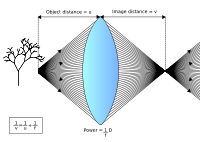A-level Physics (Advancing Physics)/Lenses
Curvature of Wavefronts
[edit | edit source]Light can be viewed as beams travelling between points. However, from most light sources, the light radiates outwards as a series of wavefronts or ripples. Light from a light source is bent - wavefronts or ripples of light have a property known as curvature.

As light travels further away from its source, its curvature decreases. Consider a sphere expanding gradually from a point, which represents a given wavefront of light. As the sphere expands, the curvature of its surface decreases when we look at any part of the surface with a constant area. It should be noted at this point that light from a source infinitely far away has 0 curvature - it is straight. This is useful, as ambient light (light from a source that is far away) can be assumed to have a curvature of 0, as the difference between this and its actual curvature is negligible.
The curvature of a wavefront is given as:
,
where v is the distance from the wavefront to the in-focus image depicted by the light. Curvature is measured in dioptres (D).
Power of lenses
[edit | edit source]
The function of a lens is to increase or decrease the curvature of a wavefront. Lenses have a 'power'. This is the curvature which the lens adds to the wavefront. Power is measured in dioptres, D, and is given by the formula:
,
where f equals the focal length of the lens, in meters. This is the distance between the lens and the point where an image will be in focus, if the wavefronts entering the other side of the lens are parallel.
The Lens Equation
[edit | edit source]
Overall, then, the formula relating the curvature of the wavefronts leaving a lens to the curvature of the wavefronts entering it is:
where v is the distance between the lens (its centre) and the in-focus image formed, u is the distance between the lens (its centre) and the object which the in-focus image is of, and f is the focal length of the lens. The power of the lens can be substituted in for the reciprocal of f, as they are the same thing.
The Cartesian Convention
[edit | edit source]If we were to place a diagram of the lens on a grid, labelled with cartesian co-ordinates, we would discover that measuring the distance of the object distance is negative, in comparison to the image distance. As a result, the value for u must always be negative. This is known as the Cartesian convention.
This means that, if light enters the lens with a positive curvature, it will leave with a negative curvature unless the lens is powerful enough to make the light leave with a positive curvature.
Types of Lens
[edit | edit source]
There are two types of lens:
Converging lenses add curvature to the wavefronts, causing them to converge more. These have a positive power, and have a curved surface which is wider in the middle than at the rim.
Diverging lenses remove curvature from the wavefronts, causing them to diverge more. These have a negative power, and have a curved surface with a dip in the middle.
Magnification
[edit | edit source]Magnification is a measure of how much an image has been enlarged by a lens. It is given by the formula:
where h1 and h2 are the heights of the image (or object) before and after being magnified, respectively. If an image is shrunk by a lens, the magnification is between 0 and 1.
Magnification can also be given as:
where v and u are the image and object distances. Therefore:
An easy way to remember this in the middle of an exam is the formula:
where I is image size, A is actual size of the object M is the magnification factor.
Questions
[edit | edit source]1. Light reflected off a cactus 1.5m from a 20D lens forms an image. How many metres is it from the other side of the lens?
3. A lens in an RGB projector causes an image to focus on a large screen. What sort of lens is it? Is its power positive or negative?
4. What is the focal length of a 100D lens?
5. The film in a camera is 5mm from a lens when automatically focussed on someone's face, 10m from the camera. What is the power of the lens?
6. The light from a candle is enlarged by a factor of 0.5 by a lens, and produces an image of a candle, 0.05m high, on a wall. What is the height of the candle?







